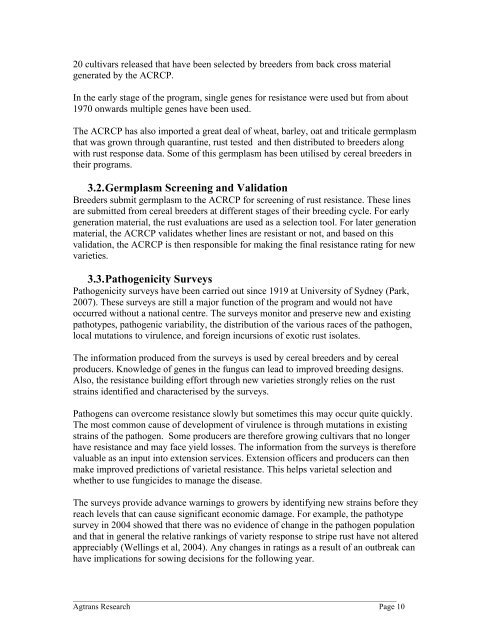An Economic Analysis of GRDC Investment in the - Grains Research ...
An Economic Analysis of GRDC Investment in the - Grains Research ...
An Economic Analysis of GRDC Investment in the - Grains Research ...
You also want an ePaper? Increase the reach of your titles
YUMPU automatically turns print PDFs into web optimized ePapers that Google loves.
20 cultivars released that have been selected by breeders from back cross material<br />
generated by <strong>the</strong> ACRCP.<br />
In <strong>the</strong> early stage <strong>of</strong> <strong>the</strong> program, s<strong>in</strong>gle genes for resistance were used but from about<br />
1970 onwards multiple genes have been used.<br />
The ACRCP has also imported a great deal <strong>of</strong> wheat, barley, oat and triticale germplasm<br />
that was grown through quarant<strong>in</strong>e, rust tested and <strong>the</strong>n distributed to breeders along<br />
with rust response data. Some <strong>of</strong> this germplasm has been utilised by cereal breeders <strong>in</strong><br />
<strong>the</strong>ir programs.<br />
3.2. Germplasm Screen<strong>in</strong>g and Validation<br />
Breeders submit germplasm to <strong>the</strong> ACRCP for screen<strong>in</strong>g <strong>of</strong> rust resistance. These l<strong>in</strong>es<br />
are submitted from cereal breeders at different stages <strong>of</strong> <strong>the</strong>ir breed<strong>in</strong>g cycle. For early<br />
generation material, <strong>the</strong> rust evaluations are used as a selection tool. For later generation<br />
material, <strong>the</strong> ACRCP validates whe<strong>the</strong>r l<strong>in</strong>es are resistant or not, and based on this<br />
validation, <strong>the</strong> ACRCP is <strong>the</strong>n responsible for mak<strong>in</strong>g <strong>the</strong> f<strong>in</strong>al resistance rat<strong>in</strong>g for new<br />
varieties.<br />
3.3. Pathogenicity Surveys<br />
Pathogenicity surveys have been carried out s<strong>in</strong>ce 1919 at University <strong>of</strong> Sydney (Park,<br />
2007). These surveys are still a major function <strong>of</strong> <strong>the</strong> program and would not have<br />
occurred without a national centre. The surveys monitor and preserve new and exist<strong>in</strong>g<br />
pathotypes, pathogenic variability, <strong>the</strong> distribution <strong>of</strong> <strong>the</strong> various races <strong>of</strong> <strong>the</strong> pathogen,<br />
local mutations to virulence, and foreign <strong>in</strong>cursions <strong>of</strong> exotic rust isolates.<br />
The <strong>in</strong>formation produced from <strong>the</strong> surveys is used by cereal breeders and by cereal<br />
producers. Knowledge <strong>of</strong> genes <strong>in</strong> <strong>the</strong> fungus can lead to improved breed<strong>in</strong>g designs.<br />
Also, <strong>the</strong> resistance build<strong>in</strong>g effort through new varieties strongly relies on <strong>the</strong> rust<br />
stra<strong>in</strong>s identified and characterised by <strong>the</strong> surveys.<br />
Pathogens can overcome resistance slowly but sometimes this may occur quite quickly.<br />
The most common cause <strong>of</strong> development <strong>of</strong> virulence is through mutations <strong>in</strong> exist<strong>in</strong>g<br />
stra<strong>in</strong>s <strong>of</strong> <strong>the</strong> pathogen. Some producers are <strong>the</strong>refore grow<strong>in</strong>g cultivars that no longer<br />
have resistance and may face yield losses. The <strong>in</strong>formation from <strong>the</strong> surveys is <strong>the</strong>refore<br />
valuable as an <strong>in</strong>put <strong>in</strong>to extension services. Extension <strong>of</strong>ficers and producers can <strong>the</strong>n<br />
make improved predictions <strong>of</strong> varietal resistance. This helps varietal selection and<br />
whe<strong>the</strong>r to use fungicides to manage <strong>the</strong> disease.<br />
The surveys provide advance warn<strong>in</strong>gs to growers by identify<strong>in</strong>g new stra<strong>in</strong>s before <strong>the</strong>y<br />
reach levels that can cause significant economic damage. For example, <strong>the</strong> pathotype<br />
survey <strong>in</strong> 2004 showed that <strong>the</strong>re was no evidence <strong>of</strong> change <strong>in</strong> <strong>the</strong> pathogen population<br />
and that <strong>in</strong> general <strong>the</strong> relative rank<strong>in</strong>gs <strong>of</strong> variety response to stripe rust have not altered<br />
appreciably (Well<strong>in</strong>gs et al, 2004). <strong>An</strong>y changes <strong>in</strong> rat<strong>in</strong>gs as a result <strong>of</strong> an outbreak can<br />
have implications for sow<strong>in</strong>g decisions for <strong>the</strong> follow<strong>in</strong>g year.<br />
________________________________________________________________________________<br />
Agtrans <strong>Research</strong> Page 10

















